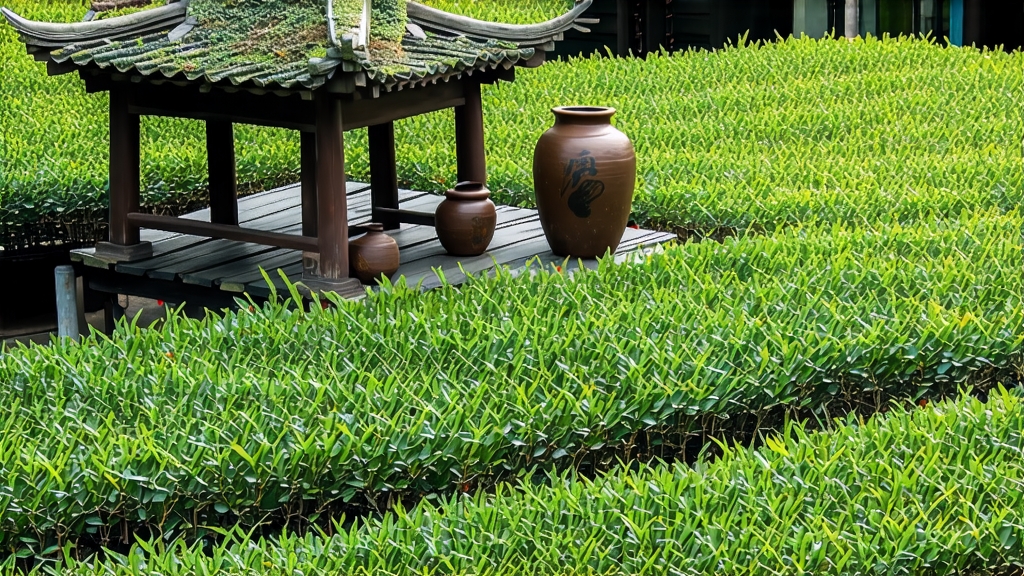
Tucked away in the humid, karst-veined mountains of southern China’s Guangxi Zhuang Autonomous Region, Liu Bao tea has spent the last four centuries quietly fermenting itself into legend. To most Western drinkers “dark tea” still means the ripe pu-erh that crowds specialty shelves, yet Liu Bao is the older, subtler ancestor—an heirloom whose flavor carries the terroir of misty river gorges, the sweat of horse caravans, and the patience of generations who believe tea can be “alive” long after the leaves have left the tree.
History: From Frontier Currency to Maritime Gold
The first written record appears in 1662, when the Qing court taxed Guangxi farmers in compressed tea bricks rather than silver. Caravans then ferried Liu Bao south to Guangzhou, where it was loaded onto junks bound for Southeast Asia. In the tin mines of Malaya and the rubber plantations of Borneo, Liu Bao became the daily wage of coolies; its ability to settle oily diets and ward off jungle humidity turned it into a surrogate currency. By 1886 the port of Wuzhou—still the tea’s spiritual home—listed Liu Bao as one of the top three export commodities alongside silk and porcelain. When the Suez Canal opened, European ships carried it to Calcutta and Rotterdam, and aging warehouses in Hong Kong still hold 1950s baskets whose wrappers bear Dutch customs stamps.
Micro-Terroir: Three Valleys, One Tea
Authentic Liu Bao can only come from the three parallel valleys of the Cangwu, Tengxian and Zhaoping counties, where the subtropical monsoon collides with mineral-rich red soils. The indigenous large-leaf Camellia sinensis var. assamica bushes grow scattered among cinnamon and longan trees; their roots drink from underground streams that filter through limestone caves, imparting a natural sweetness that chemists trace to higher levels of theobromine and gallic acid. Farmers divide the harvest into six micro-seasons, but only the spring “first fragrance” and the autumn “cold dew” pickings are deemed worthy of long aging.
Craft: When Leaves Learn to Breathe Under Water
The processing choreography begins within minutes of plucking. Leaves are wilted under banana leaves to retain 68 % moisture, then pan-fired at 180 °C for exactly four minutes—long enough to kill green enzymes yet short enough to keep the leaf spine pliable. What follows is the defining step: wet-piling, or “wo dui” in local dialect. The leaves are piled 70 cm high inside bamboo chambers lined with wet burlap; controlled turning every 24 hours introduces ambient yeasts and Bacillus subtilis that raise the heap temperature to 55 °C. After ten to fifteen days the leaf color shifts from olive to umber, and an aroma reminiscent of damp forest floor rises—an olfactory signal that the microbes have begun converting catechins into theaflavins and soluble sugars. The tea is then steamed, pressed into 40 kg bamboo baskets (“long lan”) and transferred to communal aging caves whose relative humidity hovers at 85 %. Here Liu Bao will sleep for a minimum of three years, though connoisseurs chase the 15-, 25- and even 50-year marks when the tea develops a crimson liquor so bright it refracts light like Burgundy crystal.
Grades & Shapes: A Basket of Numbers
The trade still uses the Republican-era numbering system:
- No. 1 “Song Zhen” (Pine Needle): single-bud strips, prized for honeyed finish.
- No. 2 “Gu Zi” (Grain Seed): one bud plus first leaf, balances fragrance and body.
- No. 3 “Te Zhen” (Special Needle): larger leaves, the workhorse for daily drinking.
- No. 4 “San Jian” (Three Tips): stems allowed, favored by dockworkers for strength.
- No. 5 “San Ji” (Grade Three): broken leaves, destined for dim-sum restaurants where it cuts through pork fat.
Modern producers also press Liu Bao into 100 g mini-bricks, 5 g “dragon pearls” and even 3 kg decorative coins, but purists insist the bamboo basket allows the tea to continue micro-oxidizing on its edges, creating the signature “betel-nut” note impossible to replicate in vacuum-sealed foil.
Brewing: The Gong